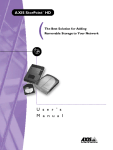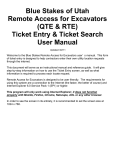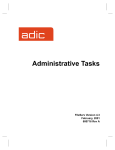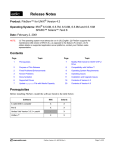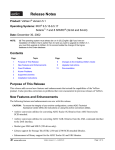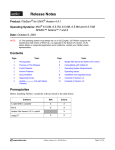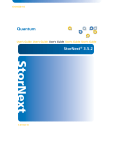Download ADIC Tool Storage Version 2.7 User's Manual
Transcript
StorNext® Storage Manager Version 2.7 Command Options Description [ -m minstoretime ] Minimum time (in minutes) that a file must reside unmodified on disk before being considered a candidate for storage on media. [ -c mintrunctime ] Syntax conventions: • italics = replace with a variable • [ ] = optional component [ -a affinity ] Lists disk affinities that the files in the policy class will traverse in their lifecycle. [ -i minreloctime ] Minimum time (in days) that a file must reside unaccessed on disk before being considered a candidate for relocation. Policy Class Management Command Options fsaddclass Description Creates and defines a new policy class. WARNING: The file system must be mounted and active before running this command or it will fail. class The policy class (maximum of 16 alphanumeric characters). [ -h hardlimit ] Maximum number of media allowed in the policy class. [ -n notifyID ] E-mail address of the user to notify when the policy class’s softlimit and hardlimit are reached. [ -t mediatype ] Defines the media type to use for the policy class. [ -l securitycode ] Security code for the policy class (up to 4 characters in length). [ -o acctnum ] Account number for the policy class (up to 5 characters in length). [ -x maxcopies ] Maximum number of copies (including the primary) allowed for each file in the policy class. [ -d defaultcopies ] Total number of stored copies (including the primary) for each file in the policy class. This value cannot exceed the maxcopies setting. [ -k maxversions ] Page 1 Maximum number of inactive versions to keep for a file. The minimum is 1 and the maximum is 25. Default: 10 Minimum time (in days) that a file must reside unaccessed on disk before being considered a candidate for truncation. Command Options Description [ class ] One or more policy classes to be listed. [ -l ] Long report - processing parameters, directory paths, and the disk affinity list for the policy class. fsmodclass Modifies the parameters of the policy class. class The policy class. [ -d defaultcopies ] Total number of copies to store (including the primary) for each file in the policy class. [ -f i | p ] File retention policy (-f) for the policy class. Files can be: [ -v drivepool ] Media Manager drive pool used to store or retrieve data for the policy class. [ -f i | p ] File retention policy (-f) for the policy class. Files can be: [ -h hardlimit ] Maximum number of media allowed in the policy class. • i - Truncated immediately • p - Truncated at policy application time [ -l securitycode ] Security code for the policy class (up to 4 characters in length). [ -m minstoretime ] Minimum time (in minutes) that a file must reside unmodified on disk before being considered a candidate for storage on media. [ -c mintrunctime ] Minimum time (in days) that a file must reside unaccessed on disk before being considered a candidate for truncation. [ -i minreloctime ] Minimum time (in days) that a file must reside unaccessed on disk before being considered a candidate for relocation. [ -n notifyID ] E-mail address of the user to notify when the policy class’s softlimit and hardlimit are reached. [ -o acctnum ] Account number for the policy class (up to 5 characters in length). [ -r c | s ] Media classification cleanup action. When all files are deleted from a medium, the medium can revert (-r) back to: [ -r c | s ] Media classification cleanup action. When all files are deleted from a medium, the medium can revert (-r) back to: • i - Truncated immediately • p - Truncated at policy application time • c - Policy class blank pool • s - System blank pool fsaddrelation Adds a directory-to-policy class association. directory Path name of the directory to associate with the policy class. WARNING: The command fails if the directory has an affinity associated with it. Use the cvaffinity command to remove its affinity. -c class Policy class to associate with the directory. NOTE: After the command completes running successfully, if the class has any affinities, the directory has its affinity set to the first affinity in the class affinity list, fsclassinfo • c - Policy class blank pool • s - System blank pool Reports policy class processing parameters, directory paths, and affinity lists. Page 2 Page 3 Command Options Description [ -s softlimit ] Warning limit for the number of media allocated in the policy class. [ -t mediatype ] Defines the media type to use. [ -a affinity ] Lists disk affinities that the files in the policy class will traverse in their lifecycle. [ -v drivepool ] [ -x maxcopies ] Command Options [ -t e | p | i ] Media Manager drive pool used to store / retrieve data. [ -s e | p ] Maximum number of copies (including the primary) allowed for each file in the policy class. Options fschstate Description [ -r e | p ] Modifies the state of storage subsystems and drive components. [ componentalias ] Alias used for storage subsystems and drive components. [ -s state ] Desired state of drive components or subsystems. Valid values: [ -a class ] • • • • • FREE IN USE FAILED DELAYED CLEANING File Management Command Options fschfiat Description Modifies the class attributes of the file. filename File having changed attributes. [ -c copies ] Number of file copies to store, including the primary. This value cannot exceed the maxcopies setting. Page 4 fspolicy Percentage of used disk space at which a truncation policy ceases to be applied. • e - Excludes the file from truncation when a store or cleanup policy application occurs. • p - Truncates the file by cleanup policy. • i - Truncates the file immediately. [ -t ] Invokes the cleanup (truncation) policy. [ -v drivepool ] Specifies the drivepool from which to allocate drives when storing files. [ -b ] Scans file system for candidate files to store, relocate or truncate and rebuilds the candidate lists. [ -y filesystem ] File system to which the policy will be applied. [ -r ] Invokes the relocation policy. [ -z minsize ] Minimum file size (in bytes) to relocate or truncate. Indicates how storage policies (-s) operate on the file: Indicates how relocation policies (-r) operate on the file. fsretrieve Specifies an alternate policy class that can be associated with the file. Policy class associated with data to be stored or truncated. [ -e ] Invokes a high priority for immediate action on file storage in a file system. [ -s ] Invokes the storage policy. [ -m minreloctime ] Minimum time (in minutes) a file must reside unaccessed on disk before being considered a candidate for relocation. [ -m minstoretime ] [ -m mintrunctime ] Minimum time (in minutes) a file must reside on disk before being considered a candidate for storage. Minimum time (in days) that a file must reside unaccessed on disk before being considered a candidate for truncation. Page 5 Description [ -o goal ] Manages disk data / space via file system or class. [ -c class ] Options Indicates how truncation policies (-t) operate on the file: • e - Excludes the file from relocation when a relocation policy occurs. • p - Relocates the file by relocation policy. • MAINT • ON • OFF Drive status. Valid values: Command • e - Excludes the file from storage when a store policy occurs. • p - Stores the file by storage policy. Device Management Command Description Retrieves or recovers files from media and places the files on disk. filename Full path and name of the file to retrieve. [ -c ] Retrieves a secondary copy of the file (if a second copy exists). [ -n newfilename ] New path and name into which to retrieve the file. -R directory Directory from which to start recursive retrieval. [ -b startbyte endbyte ] Specifies a byte range to retrieve. The value of startbyte must be less than the endbyte value. Both values must be within the file’s byte range. [ -a ] Updates the access time of the requested files. fsrmcopy Removes a copy/copies of a file from disk or media. filename File or files to remove from disk or media. [ -c copynum | a ] Deletes either a specific number (copynum) of file copies or all file copies (a) from the media. [ -m mediaID ] Deletes all files on media which reside on disk. Page 6 Command Options fsrmdiskcopy Description Removes a file copy from disk after the file is stored to media. filename fsstore Full path and name of the file copy to remove from disk. Expedites storage of data to media, instead of allowing data migration by SNMS software. filename Name of file on disk to store to media. [ -c copies ] Number of file copies to store, including the primary. [ -f i | p ] File retention policy (-f) for the file. Files can be: • i - Truncated immediately • p - Truncated at policy application time [ -t mediatype ] Defines the media type to use for storage. [ -v drivepool ] Specifies the Media Manager drive pool group used to store the file. [ -z minsize ] fsversion File System Recovery Command Options fsrecover filename [ -h ] Displays usage. [ -a ] Lists all available versions of the file (current and inactive). [ -v ] [ -c ver ] Modifies the file’s current version to the specified inactive version. [ -f ] Forces the version change. Page 7 Restores elements of a StorNext Storage Manager file system. [ -p ] Specifies a temporary storage directory for restored files. [ -h ] Displays usage. [ -e ] Extracts files to the temporary storage directory. [ -r ] restore_directory_path Uses files from this directory to restore. No files are restored from media. [ -c | cl component ] Specifies the software files restored. You can specify: Full path of the file to recover. Optionally, you can have a timestamp of the form YYYY:MM:DD:hh:mm:ss::/ stornext/smfs2/rel1/sub1/ file.a. dirpathname Full path of the directory containing file(s) to recover. -u Indicates that recovery processing is requested. -d Indicates that directory recovery processing is requested. [ -p ] Specifies that the user report display entries for which the user has permissions. If this option is not specified, the report to the user displays only user-owned entries. [ -r ] Indicates recursive processing is requested. Verbose listing of the file’s current version (version number and modification time). snrestore • -c - Restore all software configuration information. • -cl component - Restore the specified software component. Use the -h option to find a list of available components. [ -d | dj ] [ -m | -mj [ filesystem_name ] ] Indicates a time range to restrict the length of the user report. The format of the starttime and endtime parameters is: [ -a ] Specifies active files rather than recoverable files when either reporting or recovering a directory. [ -v ] Specifies the verbose mode during a recover sequence. The system reports on the recovered files. Specifies the database restore values. You can specify: • -d - Restore database and journal files. • -dj- Restore only the journal files and apply them to the existing database on the system. Specifies the file system metadata restore values. You can specify: • -m - Restore file system metadata information for all file systems or for the selected optional file system. • -mj- Restore file system journal information for all file systems or for the selected optional file system. YYYY:MM:DD:hh:mm:ss Page 8 Description Name of the file to report on. The name can be a file name, a partial path name, or a complete path name. [ RM_time:: ]filepathname [ -t starttime [ endtime ] ] Options Reports or recovers files that were removed from disk. Directory containing one or more files to recover. The name can be a directory name, partial path, or full path. Specifies the file’s current version(s). File for which the version number will be checked. Description dirname Specifies the minimum file size (in bytes) to store. name Command Page 9 Media Management Command Command Options fschmedstate Description [ -c class | -b ] Copies a data file to the destination media identifier. [ -b ] Specifies blank media for media destination. [ -f fill ] Specifies the fill level threshold (between 0 and 100%). • Changes the name of the associated policy class (-c class) [ -t mediatype ] Defines media type to use. - or - [ -u runtime ] Maximum allowable time (in hours) for the fsmedcopy command to finish. For blank media: [ -w fragmentation ] The media state. Valid values are: • • • • • • fsclean unsusp protect unprotect avail unavail unmark fsmedinfo -m mediaID The media identifier. -s filesystem The file system to clean. -c class Policy class associated with data to clean. -t [ endtime ] Endtime option. This parameter should be less than or equal to the current time. The format of the endtime parameter is: YYYY:MM:DD:hh:mm:ss mediaID The media identifier. [ -l ] Generates the long-form report which includes a list of files on the media. fsrminfo mediaID The media identifier. [ -f ] Forces the removal of database information. vsarchiveqry drivealias fsmedcopy [ -c ] Indicates that detailed information on all media classes associated with the specified archive will be reported. [ -d ] Indicates that all drives associated with the specified archive will be reported. The drive alias. Valid values: 1 to 255 characters Copies, reports or defragments media. mediaID The media identifier. [ -r ] Initiates copy-replace for a medium. Page 10 Specifies the archive (archivename) or all archives (-a) to be queried. [ -m ] Page 11 Indicates that all media associated with the specified archive will be reported. Description [ -t ] Indicates that detailed information on all media types associated with the specified archive will be reported. [ -v ] Indicates that all drives, media classes, media, and media types associated with the specified archive will be reported. [ -I ] Indicates that command line options are read from stdin. [ -h ] Requests help for the entered command. [ -H hostname ] Hostname of the Media Manager server. [ -P priority ] Execution priority of the entered command. [ -R retries ] Number of retries the CLI software attempts if a timeout is received. Default: 3 [ -T timeout ] Time interval (in seconds) that the software waits for status before returning a timeout. Default: 120 Queries for information about an archive. archivename | -a Options Default value: 15 Valid values: 1 to 32 Removes file information from the SNMS database. Default: current time Cleans the specified drive. Percentage (0 to 100%) of wasted space out of filled space on media. Generates a report on the specified media. Removes inactive file version information. fsdrvclean Command The media identifier. • Changes the policy class to system blank pool (-b). [ -s state ] Description [ -d destinationmediaID ] Modifies the state of media or a policy class to which the media belongs. mediaID Options [ -V number ] RPC program number for the software. Default: 300016 vsdriveqry Queries for information on the specified drive. driveID | -a Indicates a specific drive (driveID) or all drives (-a) will be queried. [ -I ] Indicates that command line options are to be read from stdin. [ -h ] Requests help for the entered command. [ -H hostname ] Hostname of the Media Manager server. Page 12 Command Options [ -P priority ] Description Command Execution priority of the entered command. Options [ -T timeout ] Default value: 15 Valid values: 1 to 32 [ -R retries ] Description Command Time interval (in seconds) that the software waits for status before returning a timeout. Options mediaID Specifies a media type (mediaID) or all media (-a) to be queried. [ -l ] Indicates that command line options are to be read from stdin. [ -h ] Requests help for the entered command. [ -H hostname ] Hostname of the Media Manager server. [ -P priority ] Execution priority of the entered command. Default: 120 Number of retries the CLI software attempts if a timeout is received. [ -V number ] RPC program number for the software. Default: 3 Default: 300016 [ -T timeout ] Time interval (in seconds) that the software waits for status before returning a timeout. vsmedclassqry Queries for the attributes of a media class. mediaclass Default: 120 [ -V number ] RPC program number for the software. [ -m ] Default: 15 [ -R retries ] Requests a list of media identifiers for all media associated with each reported media class. Default: 300016 vsdrivevary Specifies a media class (mediaclass) or all media classes (-a) on which to request information. Specifies the drive(s) which state is to be changed. -p drivepool Specifies the drive pool for which associated drives’ states will be changed. -s state Specifies the target state of the specified drive. [ -v ] Verbose listing (status information) of changed drives. [ -v ] Requests detailed information for all media associated with each reported media class. [ -I ] Indicates that command line options are to be read from stdin. [ -H hostname ] Hostname of the Media Manager server. [ -P priority ] [ -I ] Indicates that command line options are read from stdin. [ -h ] Requests help for the entered command. [ -H hostname ] Hostname of the Media Manager server. [ -P priority ] Execution priority of the entered command. [ -R retries ] Number of retries the CLI software attempts if a timeout is received. Default: 3 Page 13 [ -V number ] vsmedqry Page 14 Time interval (in seconds) that the software waits for status before returning a timeout. Default: 120 [ -V number ] RPC program number for the software. Default: 300016 -p drivepool Configures the specified drive pool. Default: 15 Valid values: 1 to 32 -c driveID Creates a drive pool with a list of drive identifiers. Number of retries the CLI software attempts if a timeout is received. -d Deletes the drive pool. -i driveID Inserts drives into an existing drive pool. -r driveID Removes drives from an existing drive pool. [ -l ] Indicates that command line options are to be read from stdln. [ -h ] Requests help for the entered command. Default: 300016 [ -H hostname] Hostname of the Media Manager server. Queries for the attributes of one or more specified media. [ -P priority ] Execution priority of the entered command. Execution priority of the entered command. vspoolcfg Time interval (in seconds) that the software waits for status before returning a timeout. Default: 120 Default: 15 Valid values: 1 to 32 [ -R retries ] [ -T timeout ] Default: 3 [ -T timeout ] Number of retries the CLI software attempts if a timeout is received. Default: 3 Changes a drive state. driveID Description RPC program number for the software. Page 15 Command Options Description [ -R retries ] Number of retries attempted if the software receives a timeout. [ -T timeout ] Time interval (in seconds) that the software waits for status before returning a timeout. [ -V number ] RPC program number for the software. vsreclassify Changes the media class associated with the specified media. mediaID Specifies one or more media to reclassify. -c currentmediaclass Specifies the media class with which specified media are to be associated. -n newmediaclass Specifies the new media class with which the specified media are to be associated. [ -v ] Specifies verbose output. [ -l ] Indicates that CLI options are to be read from stdin. [ -h ] Requests help for the entered command. [ -H hostname ] Hostname of the Media Manager server. [ -P priority ] Execution priority of the entered command. Default: 15 [ -R retries ] Number of retries that the software attempts if a timeout is received. Default: 3 [ -T timeout ] Time interval (in seconds) that the software waits for status before returning a timeout. Default: 120 [ -V number ] RPC program number for the software. Default: 300016 Page 16 Page 17 Page 18 Reports and Queries Command Options fsfileinfo Command Description Reports the current location of files, whether of disk, media or not in the system. filename fsqueue Full path and filename of the file. View subsystem resource requests. [-f ] Reports all files in the queue or specific files if request identifiers or filenames are specified. [ -m ] Reports media movement for a request identifier or all media in the queue. filename Path and filename of the file. [ -r requestID ] Identifier of the request to be reported. fsmedlist Policy class for which the report is to be generated. [ -g ] Reports on blank media in the general scratch pool. [ -l ] Lists media in the long report format. [ -k ] Lists all media marked for check out. [ -m ] Lists all media marked for removal. [ -b ] Lists unformatted blank media. [ -f ] Lists formatted blank media. [ -j ] Lists all media marked to contain duplicate files. [ -p ] Lists all write-protected media. [ -q ] Lists media with mark error. [ -a ] Lists all available media. [ -n ] Lists all media unavailable to SNMS software. [ -u ] Lists all media marked as unavailable but still located in SNMS system. Page 1 Description [ -s ] Lists all suspect media. [ -d ] Lists all media located in a drive. [ -h ] Lists all media located in its home slot/bin. [ -t ] Lists all media transitioning between locations. [ -z ] Lists all media exiting a storage area. [ -o ] Lists all media checked out of storage areas. fsstate Lists media in a data or storage area. [ -c class ] Options Reports the state of drive components, storage subsystem, and SNMS software. [ componentalias ] Alias for drives and storage subsystems. [ -f ] Generates a report showing the status of SNMS software. Valid states are: • Active • Not Active • Not Available fsusedspace Reports the total amount of stored, primary copy data in the SNMS system (in GB). Copyright © 1996-2006 by ADIC. All rights reserved. 6-00361-14 Rev A. ADIC Technical Assistance Center: in North America, call toll-free: 1-800-827-3822; in Europe, call toll-free: 00800-9999-3822; outside North America, go to the ADIC website at www.adic.com/contact for a complete list of toll-free numbers by country. Technical Support: www.adic.com/techsup. Page 2 Page 3







